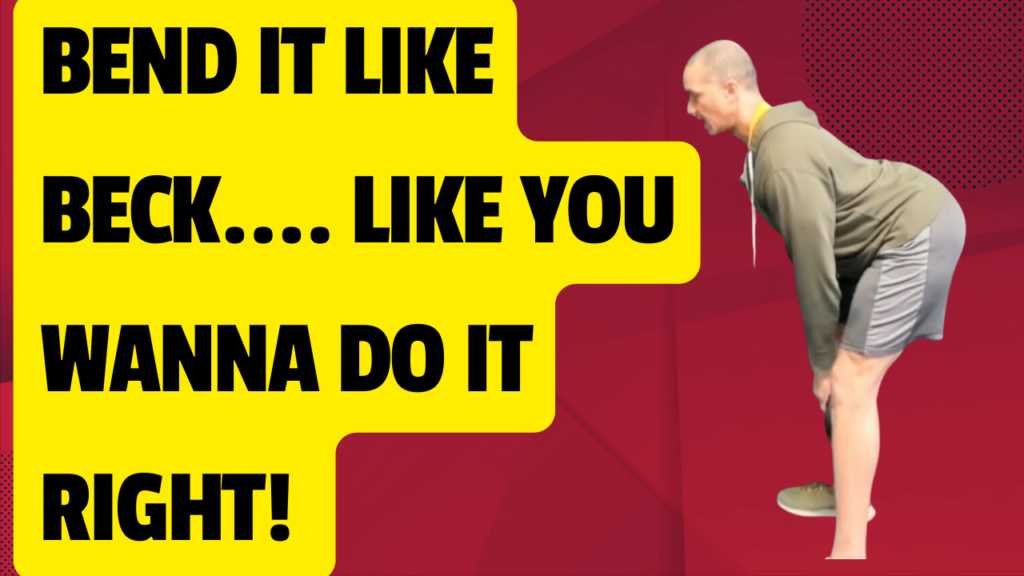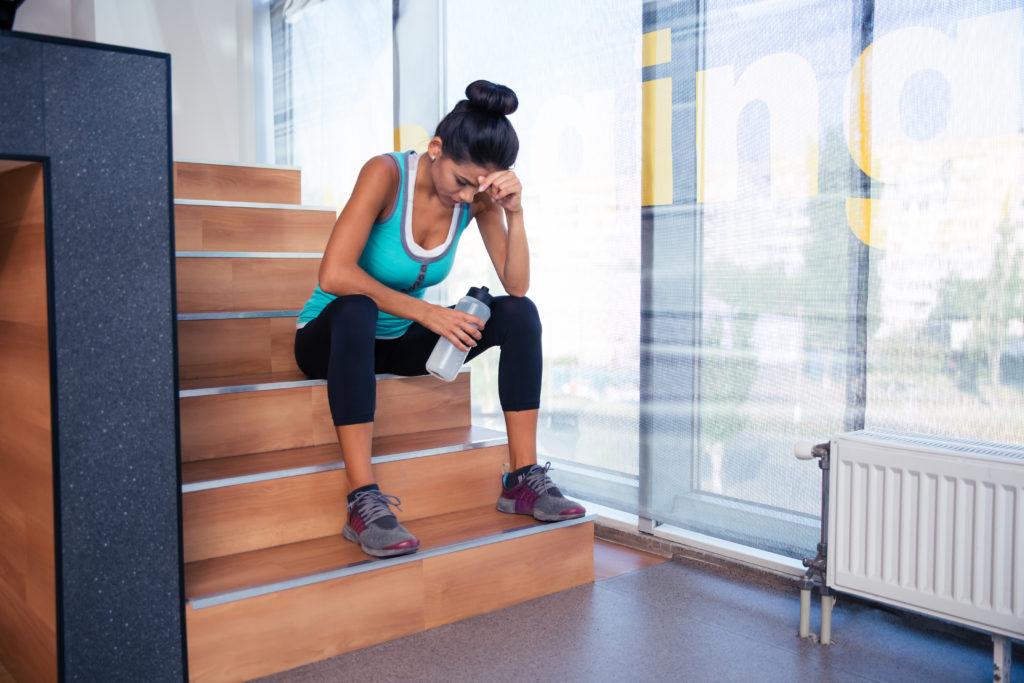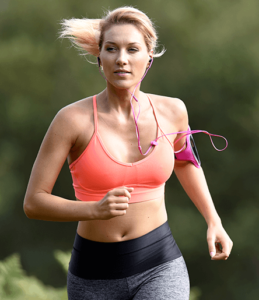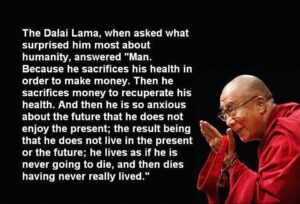Being able to bend properly will make your life much easier and less painful. But so many people don’t do it well, and it costs their bodies. But just going out and practicing the bend pattern, an RDL, or a deadlift isn’t the best first step. It is imperative to know which muscles are involved in this pattern and how they work together to help with the pattern. Watch this video to find out more.
Click the image to watch the full video

The bend pattern, or as we call it in training, the RDL or the deadlift, is a very functional and applicable movement in life. Use it all the time. You pick your kids or get grandkids off the ground, you’re playing golf, uh, you’re moving boxes around. It shows up by itself or in conjunction with other movements all the time. But if you’re not doing this movement properly, or if the chain of those muscles that are involved in that movement are dysfunctional somehow and you’re continuing to do it over and over again, then eventually that’s gonna lead to some sort of dysfunction, pain, or injury. So understanding not only how to do a, a proper bend pattern, but the muscles and and chain involved with it is very important. So that’s what we’re gonna go over with today. Greetings. I’m Ekemba Sooh. I’m the owner of SolCore Fitness.
I’ve been in this health and fitness field for 30 years. And so I started as a personal trainer, but even before that I was into athletics and I got lucky because, you know, in athletics you want to get big and strong and so you work out. And I got involved and learned from some pretty knowledgeable people about strength training and learned to do things like the bend pattern pretty well. Now, after I got out of that and became a trainer, I went even further to become an osteopathic manual therapist and an osteopathic trainer because I wanted to understand how the whole body works and how to train it and treat it holistically because that’s the way it’s designed. So when people come into my, my studio, they’ve gone away from only wanting to work out for aesthetics, right? Or to do something more egotistical. They want to live a good life, they wanna feel good, they wanna move, they wanna maintain their level of lifestyle up until the day decide that it’s time for them to die <laugh>.
And so that means the end goal is that they can do things like the bend pattern proficiently, and the bend pattern is part of the seven primal or basic movements. So you have squatting, you have the bending, pushing, pulling, twisting, lunging, and gait, right? You wanna be able to do these things proficiently and well because when you’re in life and pointing it outside right now, you’ll do these activities to perform your life. So that means I want to get them good at these seven primal movements. But unlike most exercise programs or studios or gyms, I don’t start there because the bend pattern and all the primal movements are what’s called global movements. That simply means globally my body, I have to use it as one to perform one of these movements. So I don’t wanna just start by teaching, uh uh, only how to do a bend pattern.
I wanna teach you, okay, this muscle chain tennis ligaments, these are involved in the bend pattern. Okay? What’s strong, what’s weak? What do we need to work on Once we’re in a better place for that, sure, now we can start to learn the bend pattern. So if you’re interested in hearing things, information in this holistic manner like I just talked about, then subscribe to this channel like this video and share with your friends. It tells a YouTube algorithm. It’s a good video and it’ll also show it to more people. Don’t forget to hit that bell and then stay tuned each week where I come out with new videos. So real quick, your body is a holistic living thing. That means it’s interconnected and interdependent and it’s all linked together. That means your big toe affects your head, your head fix your your fingers, right? So when you first start wanting to work on things like the bend pattern, that sound might sound obvious, but you want an assessment, but you don’t want, just like the basic assessments you get from personal trainer, you need assessment from somebody who understands the different “myo” muscle fascia, fascial chains of your body.
’cause that’s what it is. It’s not just a collection of muscles, it’s how they’re connected and the jobs they have to do along that chain. And it’s not just muscles in that chain, it’s tendons and ligaments and different fascial chains that go different areas. So you get an assessment, you want somebody to understand that and look at your pattern. But in basic, the the, uh, bend pattern, the main, uh, using chain is your posterior chain. That that’s all posterior means the back of your body, right? So from your heel, back of your leg to your glutes to your back up to your head, that’s the main chain that works. Now obviously you need the other chain, the anterior chain to help stabilize it. And those lateral chains also help stabilize it. But we’ll talk about the main chains. So we look at that, what muscles are tight or what muscles are weak or what needs to work well, they start to think about the soleus, the two gastrocs, the three main hamstrings, your glute, your four layers of back muscles, your trapezius, your rhomboids, levator scapula, and your shoulders.
All those muscles, as you’ll see here in a little bit as I do the movement, are involved in that bend pattern. Now, I’m obviously not gonna go over what to do for every single one of these chains for two reasons. One, I don’t know you and I don’t know what I, what I should be giving you because I can’t, I haven’t assessed you or talked to you. And two, it would take way too long. Again, all those muscles I talked about are just the base, the base level. But you have different ways to train different things, different ranges of motion, different, uh, a lot of different things. But it’s a combination of strengthening and stretching in these myofascial chains. What I can tell you is that in this pattern, it’s gonna put more load on your lower back than say like a squat. That’s just by the way it moves, right?
It’s not because I said so, it’s because of math, right? So it’s called a lever arm. So if I’m doing a bend pattern and my torso’s leaning for more far forward, then my shins are moving, then it’s gonna more down to my back. ’cause just try to support my torso. And if I’m reaching my arms out like that, it’s even heavier. So if you’re thinking about that, then okay, I need to train my abs and my back to stabilize my spine as I do the bend pattern. Now this, now these forces that go in your lower back aren’t inherently bad. Again, like I said, it’s just part of the movement. It’s only bad if three things, right? You haven’t trained segmentally, that chain I talked about before. All those different muscles you are, uh, doing too much weight or too much, uh, too much force in the movement or you’ve got something acute in your back.
But if you train yourself properly, those, those forces should move for your body, like all movements nicely. So when you see these reports on this position causes this much in your lower back and this position, this much in lower back, that’s true. But that’s true for a cadaver or for that static just looking. ’cause we move around. So as I do a bend pattern, that force goes into my back, put away from my back into my back, away from my back. So it doesn’t stay there ’cause I’ve got a good chain and I know how to do the movement. Are you working on your bend pattern? Are you trying to go through different progressions to make sure that you’re doing it right? Let me know the comments. So in learning any new skill and the bend pattern, if you haven’t practiced it properly, is learning a new skill. You always wanna start with the most pure movement and that pure movement is a butt back bow forward. What that means is it’s a hip dominant, uh, activity. That’s what they say in training a hip dominant as opposed to a squat, which is a knee dominant, right? So, uh, squat i, i initiate and do the main movement with my
Knees, knees and the bend pattern. I do the main movement with my hips, right?
It’s just what they call it, not big deal. So if I want, if I want to practice that, I’m gonna start with practicing that butt back, back forward in the most easy way possible, right? So as I do the butt back, bow forward as best to start kneeling. Because now when I kneel, I take away a lot more information from my body so it can focus more on what I’m doing. If I’m standing, my body all says the thing about standing. So when I do a, a butt back bow forward that posture, I wanna push my butt back and bow forward. But I wanna bow forward with a neutral spine. I don’t wanna overly tuck my pelvis, I don’t wanna stick my butt out too much. I wanna keep it neutral because as it goes back I want to keep it as neutral as possible without overly rounding or overly arching, which, which bad forces on the back, which means you want those four curves in your body.
Again, we go back to the segmental, the chains of the body. That’s something you would do prior to this if you had like a flat back. You don’t wanna do this if you have a flat tight back. Now, once I do it again, I can start my hands here, here, here or here. Gets from easiest to hardest, but I do my butt back bow forward. ’cause now I’m teaching my brain and my body, hey, this is doing a leading this is doing a following and that produces the motion. So you can work with that posture first. Then you work on two a body weight. R-D-L-R-D-L just stands for Romanian deadlift. I have no, I’m sure they, they invented it over there, but that’s just what it’s called. So an RDL is same idea that a butt back and bow forward. So I do a body weight first and then once I get that motion down, then I would choose like a lightweight.
This is light for me. So again, I would do a butt back. Whoop, that’s what you don’t want a butt back bow forward. So that’s a good point to make. As I’m doing my butt back and bowing forward, yes, my weight’s going back into my heels, but like my first one, which is terrible, you don’t want the toes coming off the ground. Yes, you’ll feel some more force going back into your heels because that’s where you’re putting force. But if your toes come off the ground, that’s bad. That po that movement, that RDL or bun bent pattern will encompass a lot of what you do in life, right? But there’s gonna be times when you need to pick things off the ground that require more force. That means you need to get good at a deadlift. So a deadlift is the same as a bend pattern, RDL, but you just add your knees.
So for the deadlift I’m doing the same thing ’cause I’ve practiced that butt back bow forward, okay, I’ve got that down now to to, to make it into a deadlift at the end of my butt, back bow forward. Like I can’t do anymore without cheating. I now bend my knees and then when I push up, I use just as much force to keep my posture. That’s what you want to look like. Now, a couple things you wanna watch out for is that people tend to, the worst thing I see it gives me a cringe face is rounding the back. People post on wherever they post on, on their workouts and look at this deadlift I’m doing and this great workout and this circuit. I’m doing a CrossFit and their back is totally rounded. If you want to kill your back, if you wanna have a terrible life round your back, you need to keep this posture just as much as you need to do the movement.
So when you go up, you need to move as one. Not that’s a good way to come see somebody like me for a long time to correct all your injuries. Now take your time when going through these, these progressions, like I said, like any new skill, it takes a lot of volume and time to do this because you’re not only trying to work your body, what you’re trying to do, do, excuse me, and develop a new motor engram in your brain. That simply means telling your brain, your body, this is how I wanna do things. Once that motor engram is set, you don’t have to think about how to do a deadlift or whatever you’ve practiced. Your body just does it. So take your time. It’s not a race, it’s about longevity. So the slower, the slower you go, the faster you end up in the end and the more proficient you end up at the end.
If you’re looking for support on training, I’d be glad to help. I’ve got a couple free resources. I’ve got a, uh, private Facebook group where we’re talking about how to be strong, mobile and flexible mainly for people in their forties and and above. I also have a free report and I also have a consultation that we can do. If you’re ready to talk about what this means for you, all three links are in the description below and all you gotta do is click on ’em, finish what you need to do and you’ll get instant access or the download or or time with me. But I hope you enjoy this. I hope you learned a lot. I’ll see you next week.

MOVE BETTER, REDUCE PAIN, AND LIVE LIFE ON YOUR TERMS
it’s not just working out, it’s building a foundation for a better life.
Find out more @



Leave a Reply